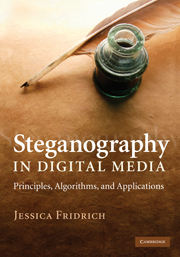Book contents
- Frontmatter
- Dedication
- Contents
- Preface
- Acknowledgments
- 1 Introduction
- 2 Digital image formats
- 3 Digital image acquisition
- 4 Steganographic channel
- 5 Naive steganography
- 6 Steganographic security
- 7 Practical steganographic methods
- 8 Matrix embedding
- 9 Non-shared selection channel
- 10 Steganalysis
- 11 Selected targeted attacks
- 12 Blind steganalysis
- 13 Steganographic capacity
- A Statistics
- B Information theory
- C Linear codes
- D Signal detection and estimation
- E Support vector machines
- Notation and symbols
- Glossary
- References
- Index
- Plate section
7 - Practical steganographic methods
Published online by Cambridge University Press: 05 April 2014
- Frontmatter
- Dedication
- Contents
- Preface
- Acknowledgments
- 1 Introduction
- 2 Digital image formats
- 3 Digital image acquisition
- 4 Steganographic channel
- 5 Naive steganography
- 6 Steganographic security
- 7 Practical steganographic methods
- 8 Matrix embedding
- 9 Non-shared selection channel
- 10 Steganalysis
- 11 Selected targeted attacks
- 12 Blind steganalysis
- 13 Steganographic capacity
- A Statistics
- B Information theory
- C Linear codes
- D Signal detection and estimation
- E Support vector machines
- Notation and symbols
- Glossary
- References
- Index
- Plate section
Summary
The definition of steganographic security given in the previous chapter should be a guiding design principle for constructing steganographic schemes. The goal is clear – to preserve the statistical distribution of cover images. Unfortunately, digital images are quite complicated objects that do not allow accurate description using simple statistical models. The biggest problem is their non-stationarity and heterogeneity. While it is possible to obtain simple models of individual small flat segments in the image, more complicated textures often present an insurmountable challenge for modeling because of a lack of data to fit an accurate local model. Moreover, and most importantly, as already hinted in Chapter 3, digital images acquired using sensors exhibit many complicated local dependences that the embedding changes may disturb and leave statistically detectable artifacts. Consequently, the lack of good image models gives space to heuristic methods.
In this chapter, we discuss four major guidelines for construction of practical steganographic schemes:
• Preserve a model of the cover source (Section 7.1);
• Make the embedding resemble some natural process (Section 7.2);
• Design the steganography to resist known steganalysis attacks (Section 7.3);
• Minimize the impact of embedding (Section 7.4).
Steganographic schemes from the first class are based on a simplified model of the cover source. The schemes are designed to preserve the model and are thus undetectable within this model.
- Type
- Chapter
- Information
- Steganography in Digital MediaPrinciples, Algorithms, and Applications, pp. 107 - 134Publisher: Cambridge University PressPrint publication year: 2009



